| ID | Category Name | Number of Texts |
|---|---|---|
| A | Press: Reportage | 44 |
| B | Press: Editorial | 27 |
| C | Press: Reviews | 17 |
| D | Religion | 17 |
| E | Skill And Hobbies | 36 |
| F | Popular Lore | 48 |
| G | Belles-Lettres | 75 |
| H | Miscellaneous: Government & House Organs | 30 |
| J | Learned | 80 |
| K | Fiction: General | 29 |
| L | Fiction: Mystery | 24 |
| M | Fiction: Science | 6 |
| N | Fiction: Adventure | 29 |
| P | Fiction: Romance | 29 |
| R | Humor | 9 |
A Short History of LLMs
Background and introduction to NLP
Fall 2025
Overview
Overview
How did we get to large language models (LLMs)
- Our topics
- Review some history of natural language processing (NLP) and digital writing technologies
- Look at the architectures of models and how they’ve changed over time
- Share the results of some research and discuss some of the potential implications
Overview
How did we get to large language models (LLMs)
- Our goals
- Show how these technologies fundamentally work.
- Introduce some foundational concepts in NLP.
- Walk though some considerations of research design.
History
History
Writing is inseparable from technological change (Gabrial 2007)
History
Writing is inseparable from technological change
New surfaces:
papyrus
parchment
wood-pulp paper
History
Writing is inseparable from technological change
History
Writing is inseparable from technological change
New implements:
stylus
metal-tipped pen
mass-produced pencil
History
Writing is inseparable from technological change
History
Writing is inseparable from technological change
New systems:
libraries
postal networks
commercial publishers
History
Writing is inseparable from technological change
- Technological change is often met with skepticism, if not hostility and fear.

Think of the moral and intellectual training that comes to a student who writes a manuscript with the knowledge that his [sic] errors will stand out on the page as honestly confessed and openly advertised mistakes. (S. Y. G. 1908)
History
Writing is inseparable from technological change
- Technological change is often met with skepticism, if not hostility and fear.
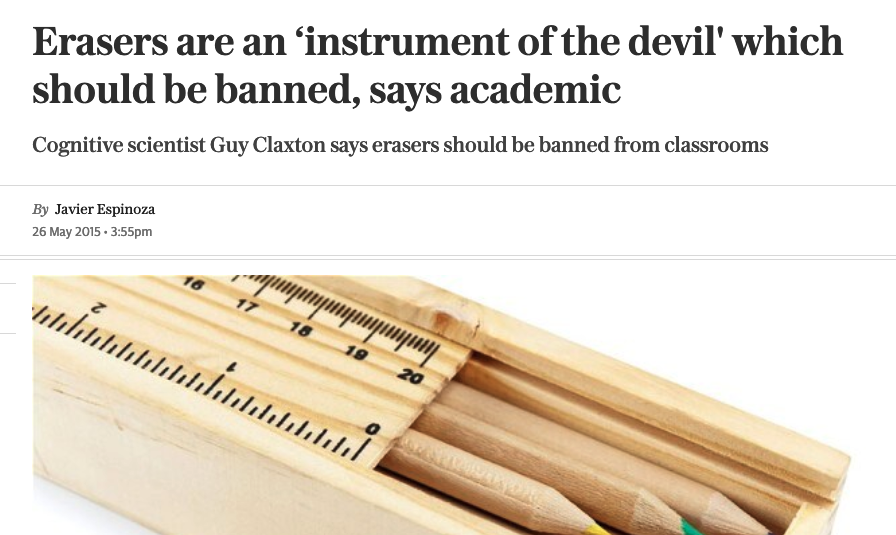
The eraser is an instrument of the devil because it perpetuates a culture of shame about error. It’s a way of lying to the world, which says ‘I didn’t make a mistake. I got it right first time.’ That’s what happens when you can rub it out and replace it. Instead, we need a culture where children are not afraid to make mistakes, they look at their mistakes and they learn from them, where they are continuously reflecting and improving on what they’ve done, not being enthralled to getting the right answer quickly and looking smart. (Espinoza 2015)
History
Writing is inseparable from technological change
In 2009, researchers at Google published an article that coincided with the release of its N-gram Viewer and the corresponding data tables (Halevy, Norvig, and Pereira 2009).
But the fact that it’s a million times larger than the Brown Corpus outweighs these drawbacks. A trillion-word corpus—along with other Web-derived corpora of millions, billions, or trillions of links, videos, images, tables, and user interactions—captures even very rare aspects of human behavior. So, this corpus could serve as the basis of a complete model for certain tasks—if only we knew how to extract the model from the data.
We will return to this excerpt, but for now, let’s focus on this final claim…
History
The concept of a language model has been around for a long time…
- speech recognition (Bahl, Jelinek, and Mercer 1983; Jelinek 1985)
- spelling correction (Mays, Damerau, and Mercer 1991)
- machine translation (Brown et al. 1990)
History
The concept of a language model has been around for a long time…
- machine translation (Brown et al. 1990)
History
The concept of a language model has been around for a long time…
- machine translation (Brown et al. 1990)
History
The concept of a language model has been around for a long time…

1960-1980
Beginnings of NLP
1980-2015
Towards Computation
2015-
Emergence of ML
History
The concept of a language model has been around for a long time…

The beginnings of NLP
The beginnings of NLP
The question of multiple meanings (or polysemy)
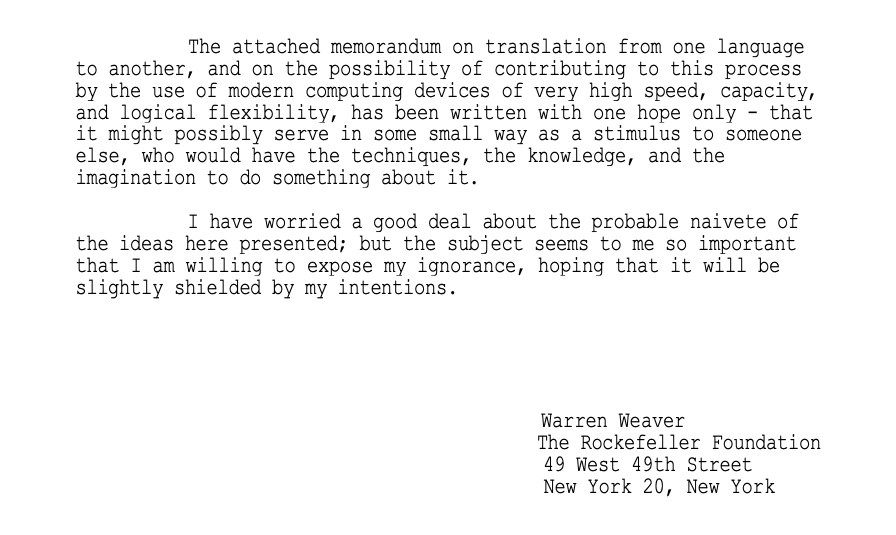
A memo shared with a small group of researchers who were at the forefront of machine translation after WWII, anticipates the challenges and possibilities of the computer analysis of text. (Weaver 1949)
The beginnings of NLP
The question of multiple meanings (or polysemy)
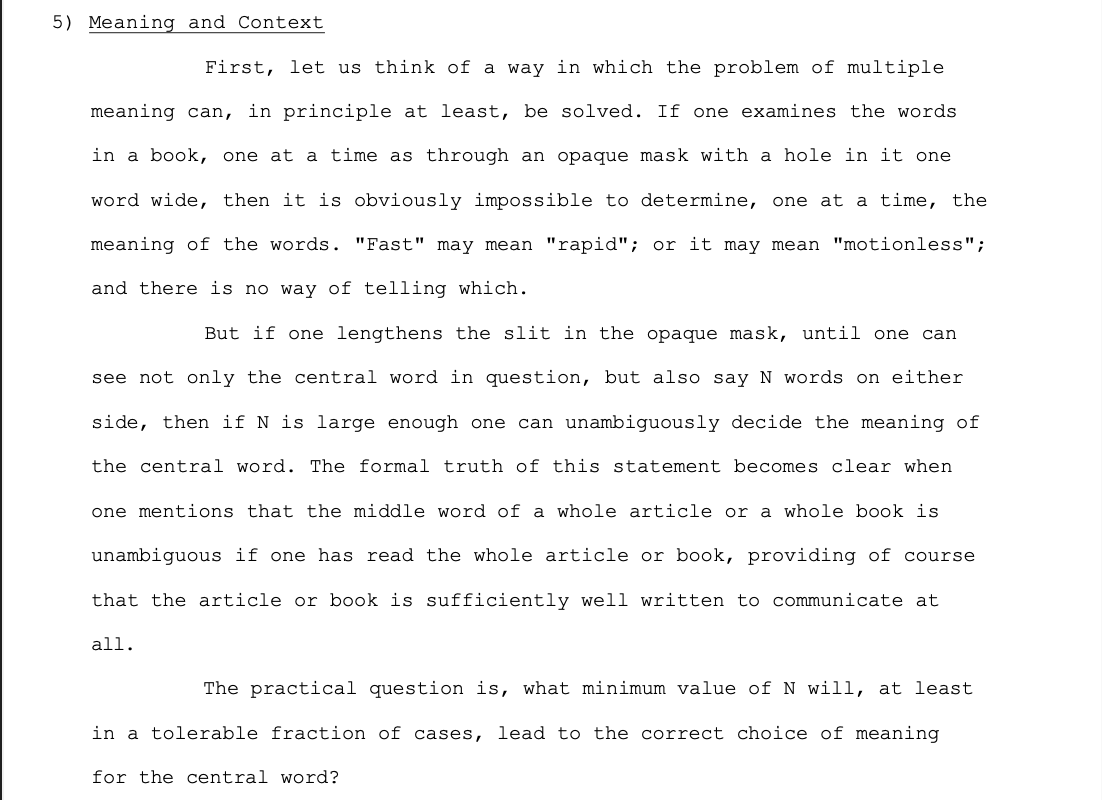
If one examines the words in a book, one at a time as through an opaque mask with a hole in it on word wide, then it is obviously impossible to determine, one at a time, the meaning of words.
The beginnings of NLP
The question of multiple meanings (or polysemy)

But if one lengthens the slit in the opaque mask, until one can see not only the central word in question, but also say N words on either side, then if N is large enough one can unambiguously decide the meaning of the central word.
The beginnings of NLP
The question of multiple meanings (or polysemy)

The practical question is, what minimum value of N will, at least in a tolerable fraction of cases, lead to the correct choice of meaning for the central word?
The beginnings of NLP
The question of multiple meanings (or polysemy)
- “You shall know a word by the company it keeps.” (Firth 1957)
- The meaning of word can be determined by examining the contextual window or span around that word.
The beginnings of NLP
The question of multiple meanings (or polysemy)
| Pre-node | Node | Post-node |
|---|---|---|
| upscaling generally hold | fast | during a 4K 60FPS gaming session. |
| a dragster, going | fast | in a straight line is actually pretty boring |
| The benefits of the | fast | can be maintained long term, |
| adopted slowly, but comes on | fast | once it’s hit the mainstream |
| They simply disagree on how | fast | to go and how best to get there in superseding it. |
| which appeared stuck | fast | in the ground it had plowed up |
The beginnings of NLP
The question of multiple meanings (or polysemy)
| Pre-node | Node | Post-node |
|---|---|---|
| upscaling generally hold | fast | during a 4K 60FPS gaming session. |
| a dragster, going | fast | in a straight line is actually pretty boring |
| The benefits of the | fast | can be maintained long term, |
| adopted slowly, but comes on | fast | once it’s hit the mainstream |
| They simply disagree on how | fast | to go and how best to get there in superseding it. |
| which appeared stuck | fast | in the ground it had plowed up |
The beginnings of NLP
The question of multiple meanings (or polysemy)
| Pre-node | Node | Post-node |
|---|---|---|
| upscaling generally hold | fast | during a 4K 60FPS gaming session. |
| a dragster, going | fast | in a straight line is actually pretty boring |
| The benefits of the | fast | can be maintained long term, |
| adopted slowly, but comes on | fast | once it’s hit the mainstream |
| They simply disagree on how | fast | to go and how best to get there in superseding it. |
| which appeared stuck | fast | in the ground it had plowed up |
The beginnings of NLP
- The “context window” is a fundamental insight that powers the training of LLMs (from word2vec to BERT to ChatGPT).

The beginnings of NLP
As early as the mid-twentieth century, researchers…
had considered the potential for a “context window” to solve word-sense disambiguation
were developing the statistical tools that would eventually power the training of LLMs (i.e., neural networks).
Question
Why didn’t we have LLMs sooner?
The beginnings of NLP
Context free grammar
- To cope with these limitations (and beliefs about language structure) early models resorted to hard-coding rules
S → NP VP
NP → the N
VP → V NP
V → sings | eats
N → cat | song | canary
– the canary sings the song
– the song eats the cat
The beginnings of NLP
Context free grammar
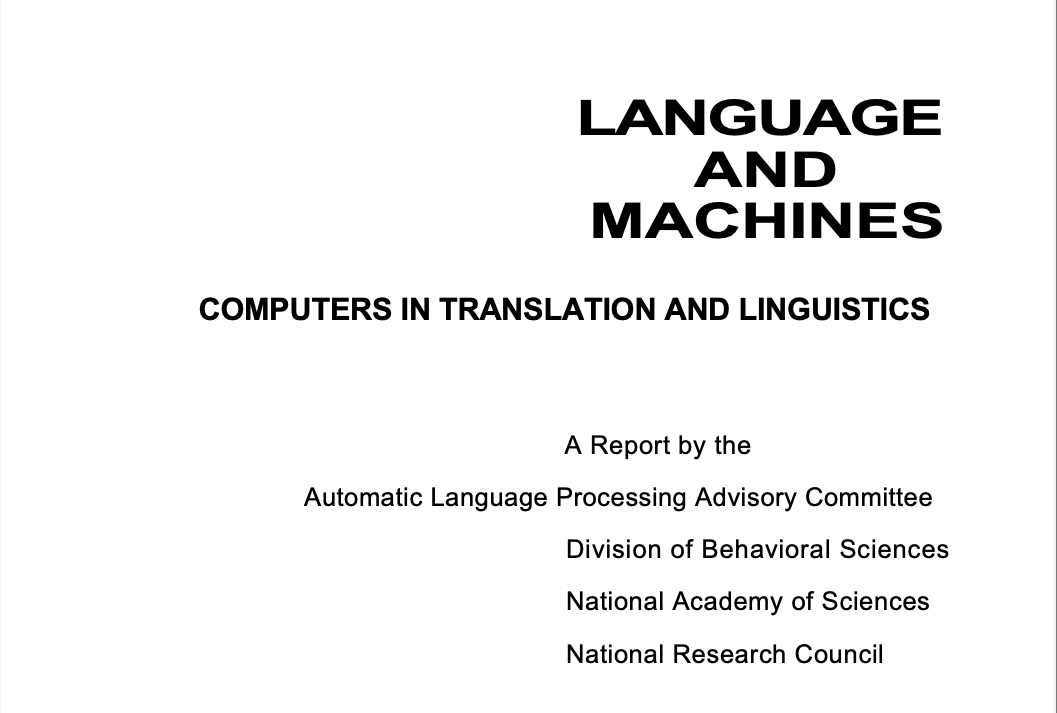
The ALPAC Report, which was released in 1966, was highly skeptical of these kinds of approaches.
The beginnings of NLP
Context free grammar

…we do not have useful machine translation. Furthermore, there is no immediate or predictable prospect of useful machine translation.
The beginnings of NLP
Context free grammar
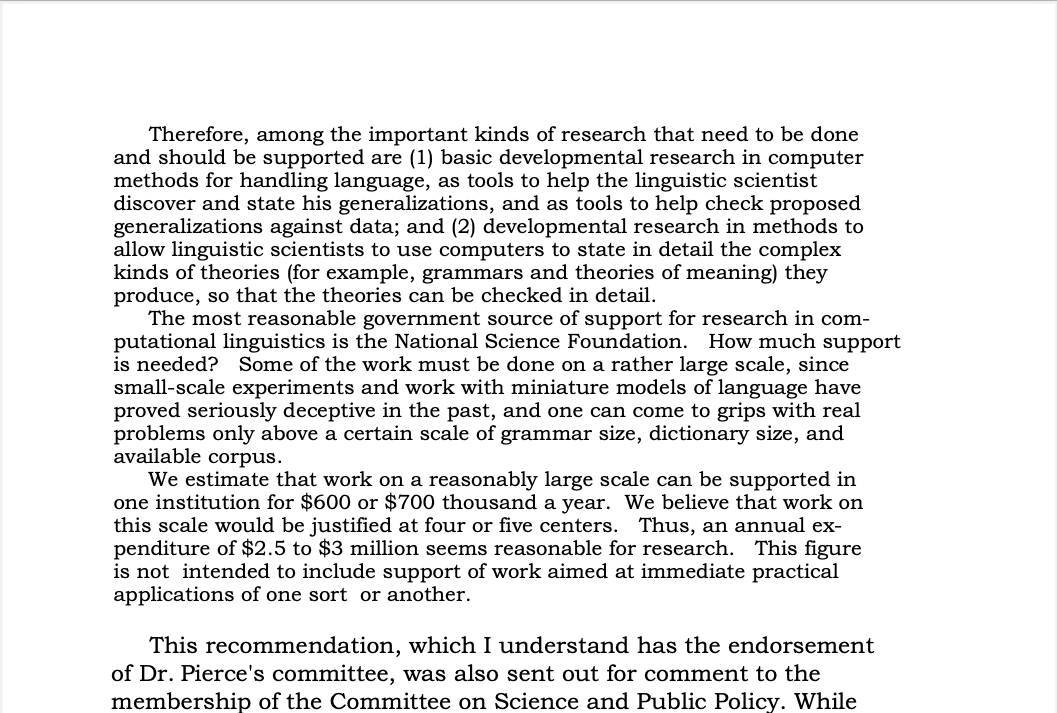
Some of the work must be done on a rather large scale, since small-scale experiments and work with miniature models of language have proved seriously deceptive in the past, and one can come to grips with real problems only above a certain scale of grammar size, dictionary size, and available corpus.
Towards computation
Towards computation
Converting words into numbers (a typical processing pipeline)
Towards computation
Constructing a corpus
- The make-up or sampling frame of the Brown family of corpora. (Kučera and Francis 1967)
- From the 15 categories, 2,000-word text samples were selected.
- 2,000 x 500 ≈ 1,000,000 words
Towards computation
A document-feature matrix (or a document-term matrix)
| doc_id | the | of | and | to | a | in | that | is | was | he | for | it | with | as | his | → |
|---|---|---|---|---|---|---|---|---|---|---|---|---|---|---|---|---|
| A01 | 155 | 65 | 40 | 55 | 54 | 40 | 28 | 12 | 18 | 7 | 22 | 19 | 6 | 13 | 12 | → |
| A02 | 134 | 94 | 33 | 56 | 51 | 36 | 11 | 11 | 15 | 13 | 24 | 15 | 6 | 14 | 6 | → |
| A03 | 150 | 65 | 40 | 62 | 43 | 42 | 12 | 12 | 11 | 19 | 34 | 5 | 7 | 7 | 9 | → |
| A04 | 160 | 68 | 45 | 52 | 38 | 58 | 33 | 14 | 13 | 12 | 19 | 13 | 9 | 17 | 6 | → |
| A05 | 167 | 61 | 34 | 72 | 54 | 42 | 41 | 14 | 15 | 45 | 27 | 9 | 10 | 8 | 6 | → |
| A06 | 150 | 77 | 37 | 52 | 54 | 43 | 18 | 28 | 12 | 32 | 31 | 10 | 15 | 8 | 15 | → |
| A07 | 167 | 65 | 43 | 54 | 39 | 55 | 17 | 32 | 12 | 11 | 29 | 8 | 16 | 16 | 9 | → |
| A08 | 183 | 69 | 29 | 58 | 39 | 49 | 15 | 25 | 4 | 9 | 14 | 22 | 15 | 11 | 8 | → |
| A09 | 187 | 64 | 44 | 42 | 51 | 37 | 18 | 10 | 28 | 10 | 40 | 8 | 8 | 10 | 9 | → |
| A10 | 134 | 64 | 36 | 64 | 38 | 48 | 21 | 19 | 10 | 20 | 29 | 12 | 12 | 14 | 9 | → |
| A11 | 151 | 40 | 49 | 55 | 71 | 58 | 5 | 3 | 14 | 6 | 22 | 6 | 12 | 15 | 11 | → |
| A12 | 113 | 38 | 44 | 29 | 58 | 54 | 14 | 7 | 14 | 35 | 25 | 16 | 11 | 11 | 13 | → |
| A13 | 161 | 50 | 47 | 39 | 63 | 55 | 6 | 8 | 27 | 11 | 12 | 12 | 18 | 11 | 20 | → |
| A14 | 172 | 61 | 41 | 39 | 76 | 40 | 15 | 15 | 20 | 34 | 22 | 14 | 18 | 15 | 17 | → |
| A15 | 136 | 24 | 46 | 46 | 60 | 35 | 27 | 11 | 19 | 17 | 23 | 7 | 18 | 22 | 17 | → |
| ↓ | ↓ | ↓ | ↓ | ↓ | ↓ | ↓ | ↓ | ↓ | ↓ | ↓ | ↓ | ↓ | ↓ | ↓ | ↓ |
Towards computation
A document-feature matrix (or a document-term matrix)
| doc_id | the | of | and | to | a | in | that | is | was | he | for | it | with | as | his | → |
|---|---|---|---|---|---|---|---|---|---|---|---|---|---|---|---|---|
| A01 | 155 | 65 | 40 | 55 | 54 | 40 | 28 | 12 | 18 | 7 | 22 | 19 | 6 | 13 | 12 | → |
| A02 | 134 | 94 | 33 | 56 | 51 | 36 | 11 | 11 | 15 | 13 | 24 | 15 | 6 | 14 | 6 | → |
| A03 | 150 | 65 | 40 | 62 | 43 | 42 | 12 | 12 | 11 | 19 | 34 | 5 | 7 | 7 | 9 | → |
| A04 | 160 | 68 | 45 | 52 | 38 | 58 | 33 | 14 | 13 | 12 | 19 | 13 | 9 | 17 | 6 | → |
| A05 | 167 | 61 | 34 | 72 | 54 | 42 | 41 | 14 | 15 | 45 | 27 | 9 | 10 | 8 | 6 | → |
| A06 | 150 | 77 | 37 | 52 | 54 | 43 | 18 | 28 | 12 | 32 | 31 | 10 | 15 | 8 | 15 | → |
| A07 | 167 | 65 | 43 | 54 | 39 | 55 | 17 | 32 | 12 | 11 | 29 | 8 | 16 | 16 | 9 | → |
| A08 | 183 | 69 | 29 | 58 | 39 | 49 | 15 | 25 | 4 | 9 | 14 | 22 | 15 | 11 | 8 | → |
| A09 | 187 | 64 | 44 | 42 | 51 | 37 | 18 | 10 | 28 | 10 | 40 | 8 | 8 | 10 | 9 | → |
| A10 | 134 | 64 | 36 | 64 | 38 | 48 | 21 | 19 | 10 | 20 | 29 | 12 | 12 | 14 | 9 | → |
| A11 | 151 | 40 | 49 | 55 | 71 | 58 | 5 | 3 | 14 | 6 | 22 | 6 | 12 | 15 | 11 | → |
| A12 | 113 | 38 | 44 | 29 | 58 | 54 | 14 | 7 | 14 | 35 | 25 | 16 | 11 | 11 | 13 | → |
| A13 | 161 | 50 | 47 | 39 | 63 | 55 | 6 | 8 | 27 | 11 | 12 | 12 | 18 | 11 | 20 | → |
| A14 | 172 | 61 | 41 | 39 | 76 | 40 | 15 | 15 | 20 | 34 | 22 | 14 | 18 | 15 | 17 | → |
| A15 | 136 | 24 | 46 | 46 | 60 | 35 | 27 | 11 | 19 | 17 | 23 | 7 | 18 | 22 | 17 | → |
| ↓ | ↓ | ↓ | ↓ | ↓ | ↓ | ↓ | ↓ | ↓ | ↓ | ↓ | ↓ | ↓ | ↓ | ↓ | ↓ |
Towards computation
A document-feature matrix (or a document-term matrix)
| doc_id | the | of | and | to | a | in | that | is | was | he | for | it | with | as | his | → |
|---|---|---|---|---|---|---|---|---|---|---|---|---|---|---|---|---|
| A01 | 155 | 65 | 40 | 55 | 54 | 40 | 28 | 12 | 18 | 7 | 22 | 19 | 6 | 13 | 12 | → |
| A02 | 134 | 94 | 33 | 56 | 51 | 36 | 11 | 11 | 15 | 13 | 24 | 15 | 6 | 14 | 6 | → |
| A03 | 150 | 65 | 40 | 62 | 43 | 42 | 12 | 12 | 11 | 19 | 34 | 5 | 7 | 7 | 9 | → |
| A04 | 160 | 68 | 45 | 52 | 38 | 58 | 33 | 14 | 13 | 12 | 19 | 13 | 9 | 17 | 6 | → |
| A05 | 167 | 61 | 34 | 72 | 54 | 42 | 41 | 14 | 15 | 45 | 27 | 9 | 10 | 8 | 6 | → |
| A06 | 150 | 77 | 37 | 52 | 54 | 43 | 18 | 28 | 12 | 32 | 31 | 10 | 15 | 8 | 15 | → |
| A07 | 167 | 65 | 43 | 54 | 39 | 55 | 17 | 32 | 12 | 11 | 29 | 8 | 16 | 16 | 9 | → |
| A08 | 183 | 69 | 29 | 58 | 39 | 49 | 15 | 25 | 4 | 9 | 14 | 22 | 15 | 11 | 8 | → |
| A09 | 187 | 64 | 44 | 42 | 51 | 37 | 18 | 10 | 28 | 10 | 40 | 8 | 8 | 10 | 9 | → |
| A10 | 134 | 64 | 36 | 64 | 38 | 48 | 21 | 19 | 10 | 20 | 29 | 12 | 12 | 14 | 9 | → |
| A11 | 151 | 40 | 49 | 55 | 71 | 58 | 5 | 3 | 14 | 6 | 22 | 6 | 12 | 15 | 11 | → |
| A12 | 113 | 38 | 44 | 29 | 58 | 54 | 14 | 7 | 14 | 35 | 25 | 16 | 11 | 11 | 13 | → |
| A13 | 161 | 50 | 47 | 39 | 63 | 55 | 6 | 8 | 27 | 11 | 12 | 12 | 18 | 11 | 20 | → |
| A14 | 172 | 61 | 41 | 39 | 76 | 40 | 15 | 15 | 20 | 34 | 22 | 14 | 18 | 15 | 17 | → |
| A15 | 136 | 24 | 46 | 46 | 60 | 35 | 27 | 11 | 19 | 17 | 23 | 7 | 18 | 22 | 17 | → |
| ↓ | ↓ | ↓ | ↓ | ↓ | ↓ | ↓ | ↓ | ↓ | ↓ | ↓ | ↓ | ↓ | ↓ | ↓ | ↓ |
Towards computation
Zipf’s Law
Most frequent words:
the
of
and
Towards computation
Zipf’s Law
Towards computation
Zipf’s Law
- Zipf’s Law: the frequency of a token is inversely proportional to its rank.
- Most tokens are infrequent.
- The absence of evidence is not evidence of absence.
Towards computation
While some words may be normally distributed, most are not.
Emergence of machine learning
Emergence of ML
Let’s return to the excerpt from the Google researchers.
But the fact that it’s a million times larger than the Brown Corpus outweighs these drawbacks. A trillion-word corpus—along with other Web-derived corpora of millions, billions, or trillions of links, videos, images, tables, and user interactions—captures even very rare aspects of human behavior. So, this corpus could serve as the basis of a complete model for certain tasks—if only we knew how to extract the model from the data.
Question
What developments are taking place at this time (the early 2000s)?
Emergence of ML
- Word2vec is released. (Mikolov et al. 2013)
- Shallow (2-layer) neural network.
- Trained using a relatively small context window (~10–12 words).
- Introduces “embeddings”.
Emergence of ML
Embeddings from a vector model.
| token | X1 | X2 | X3 | X4 | X5 | X6 | X7 | X8 | X9 | X10 | X11 | X12 | → |
|---|---|---|---|---|---|---|---|---|---|---|---|---|---|
| the | -0.168845 | -0.461962 | -0.19786 | 0.274797 | -0.125103 | -0.706765 | -0.003869 | 0.433402 | 0.346452 | 0.040093 | 0.203006 | 0.090101 | → |
| of | -0.156332 | -0.205717 | 0.227799 | 0.168333 | -0.124179 | -0.942517 | -0.006047 | 0.354843 | 0.581821 | 0.178699 | 0.115994 | 0.260422 | → |
| and | -0.35421 | -0.577716 | -0.264329 | 0.391706 | -0.121148 | -0.53797 | -0.02144 | 0.292083 | 0.166029 | 0.122325 | 0.112165 | 0.363388 | → |
| to | -0.188663 | -0.475612 | -0.165088 | 0.557264 | -0.175906 | -0.470315 | -0.143031 | 0.54875 | 0.024778 | 0.027579 | 0.337273 | 0.035197 | → |
| a | -0.746083 | -0.16305 | -0.068605 | 0.621801 | 0.339663 | -0.257003 | -0.076629 | 0.699464 | 0.013988 | -0.189733 | 0.005224 | 0.551253 | → |
| in | -0.234889 | -0.871305 | 0.186019 | -0.099154 | -0.243639 | -0.591907 | -0.049697 | 0.545955 | -0.03968 | 0.095335 | 0.02752 | 0.127082 | → |
| i | -0.187752 | -0.189067 | 0.54628 | 0.98086 | -0.063788 | -0.047667 | -0.040399 | 0.858812 | -0.089908 | -0.080435 | -0.035776 | -0.223912 | → |
| that | -0.122229 | -1.068663 | 0.203545 | -0.139743 | -0.047583 | 0.257451 | 0.241411 | 0.277364 | 0.427474 | 0.194155 | -0.288758 | -0.192211 | → |
| it | -0.116662 | -0.151302 | -0.215672 | 0.597628 | 0.053331 | -0.452194 | 0.164938 | 0.62079 | 0.213103 | -0.325304 | 0.023041 | -0.108058 | → |
| he | 0.264217 | -1.258926 | 0.16205 | 0.105418 | 0.100143 | 0.165211 | 0.135424 | 0.320132 | 0.002697 | 0.306683 | -0.366043 | 0.273684 | → |
| was | 0.228962 | -0.237645 | -0.334393 | 0.621722 | 0.014987 | 0.193712 | 0.389216 | -0.200413 | -0.368847 | 0.021749 | 0.178661 | 0.271978 | → |
| his | -0.255955 | -0.587171 | -0.257692 | 0.766715 | -0.266811 | 0.074266 | 0.100724 | 0.117419 | -0.405978 | 0.719568 | -0.003845 | 0.628617 | → |
| is | -0.491186 | -0.487561 | -0.074739 | -0.115964 | 0.181698 | -0.465943 | 0.267144 | 0.468609 | 0.971713 | 0.199609 | -0.013295 | 0.234851 | → |
| as | -0.242131 | -0.138365 | -0.660047 | 0.03217 | -0.077236 | -0.672038 | -0.807216 | 0.308242 | 0.058584 | 0.009522 | 0.121514 | 0.359722 | → |
| with | -0.114715 | -0.390149 | 0.115776 | -0.170354 | 0.055223 | -0.112999 | -0.208434 | 0.254655 | 0.562462 | 0.362516 | -0.401538 | 0.353187 | → |
| ↓ | ↓ | ↓ | ↓ | ↓ | ↓ | ↓ | ↓ | ↓ | ↓ | ↓ | ↓ | ↓ |
Emergence of ML
Embeddings from a vector model.
| token | X1 | X2 | X3 | X4 | X5 | X6 | X7 | X8 | X9 | X10 | X11 | X12 | → |
|---|---|---|---|---|---|---|---|---|---|---|---|---|---|
| the | -0.168845 | -0.461962 | -0.19786 | 0.274797 | -0.125103 | -0.706765 | -0.003869 | 0.433402 | 0.346452 | 0.040093 | 0.203006 | 0.090101 | → |
| of | -0.156332 | -0.205717 | 0.227799 | 0.168333 | -0.124179 | -0.942517 | -0.006047 | 0.354843 | 0.581821 | 0.178699 | 0.115994 | 0.260422 | → |
| and | -0.35421 | -0.577716 | -0.264329 | 0.391706 | -0.121148 | -0.53797 | -0.02144 | 0.292083 | 0.166029 | 0.122325 | 0.112165 | 0.363388 | → |
| to | -0.188663 | -0.475612 | -0.165088 | 0.557264 | -0.175906 | -0.470315 | -0.143031 | 0.54875 | 0.024778 | 0.027579 | 0.337273 | 0.035197 | → |
| a | -0.746083 | -0.16305 | -0.068605 | 0.621801 | 0.339663 | -0.257003 | -0.076629 | 0.699464 | 0.013988 | -0.189733 | 0.005224 | 0.551253 | → |
| in | -0.234889 | -0.871305 | 0.186019 | -0.099154 | -0.243639 | -0.591907 | -0.049697 | 0.545955 | -0.03968 | 0.095335 | 0.02752 | 0.127082 | → |
| i | -0.187752 | -0.189067 | 0.54628 | 0.98086 | -0.063788 | -0.047667 | -0.040399 | 0.858812 | -0.089908 | -0.080435 | -0.035776 | -0.223912 | → |
| that | -0.122229 | -1.068663 | 0.203545 | -0.139743 | -0.047583 | 0.257451 | 0.241411 | 0.277364 | 0.427474 | 0.194155 | -0.288758 | -0.192211 | → |
| it | -0.116662 | -0.151302 | -0.215672 | 0.597628 | 0.053331 | -0.452194 | 0.164938 | 0.62079 | 0.213103 | -0.325304 | 0.023041 | -0.108058 | → |
| he | 0.264217 | -1.258926 | 0.16205 | 0.105418 | 0.100143 | 0.165211 | 0.135424 | 0.320132 | 0.002697 | 0.306683 | -0.366043 | 0.273684 | → |
| was | 0.228962 | -0.237645 | -0.334393 | 0.621722 | 0.014987 | 0.193712 | 0.389216 | -0.200413 | -0.368847 | 0.021749 | 0.178661 | 0.271978 | → |
| his | -0.255955 | -0.587171 | -0.257692 | 0.766715 | -0.266811 | 0.074266 | 0.100724 | 0.117419 | -0.405978 | 0.719568 | -0.003845 | 0.628617 | → |
| is | -0.491186 | -0.487561 | -0.074739 | -0.115964 | 0.181698 | -0.465943 | 0.267144 | 0.468609 | 0.971713 | 0.199609 | -0.013295 | 0.234851 | → |
| as | -0.242131 | -0.138365 | -0.660047 | 0.03217 | -0.077236 | -0.672038 | -0.807216 | 0.308242 | 0.058584 | 0.009522 | 0.121514 | 0.359722 | → |
| with | -0.114715 | -0.390149 | 0.115776 | -0.170354 | 0.055223 | -0.112999 | -0.208434 | 0.254655 | 0.562462 | 0.362516 | -0.401538 | 0.353187 | → |
| ↓ | ↓ | ↓ | ↓ | ↓ | ↓ | ↓ | ↓ | ↓ | ↓ | ↓ | ↓ | ↓ |
Emergence of ML
Embeddings from a vector model.
- When treated as coordinates in space, embeddings locate words that tend to appear together or in similar contexts near each other.
Emergence of ML
Embeddings from a vector model.
- The proximity of words can be assessed using measures like cosine similarity.
\[
cosine~similarity = S_{c}(A, B) := cos(\theta) = \frac{A \cdot B}{||A||~||B||}
\] 
Emergence of ML
- An example of a vector model rendered in 3 dimensions from https://projector.tensorflow.org/.
Emergence of ML
Embeddings from a vector model.
| token | similarity |
|---|---|
| slow | 0.448 |
| quick | 0.519 |
| faster | 0.568 |
| slower | 0.593 |
| speed | 0.602 |
| busy | 0.646 |
| simple | 0.663 |
| food | 0.676 |
| speeds | 0.688 |
| fastest | 0.688 |
| pace | 0.697 |
| efficient | 0.703 |
| easy | 0.707 |
| small | 0.710 |
| too | 0.712 |
| straight | 0.717 |
| rapid | 0.717 |
| low | 0.718 |
| quickly | 0.718 |
| packet | 0.718 |
Emergence of ML
- After the introduction of vector representations and, a short time later, the transformer architecture (Vaswani et al. 2017), language models have rapidly evolved. They can be grouped into roughly 3 generations.
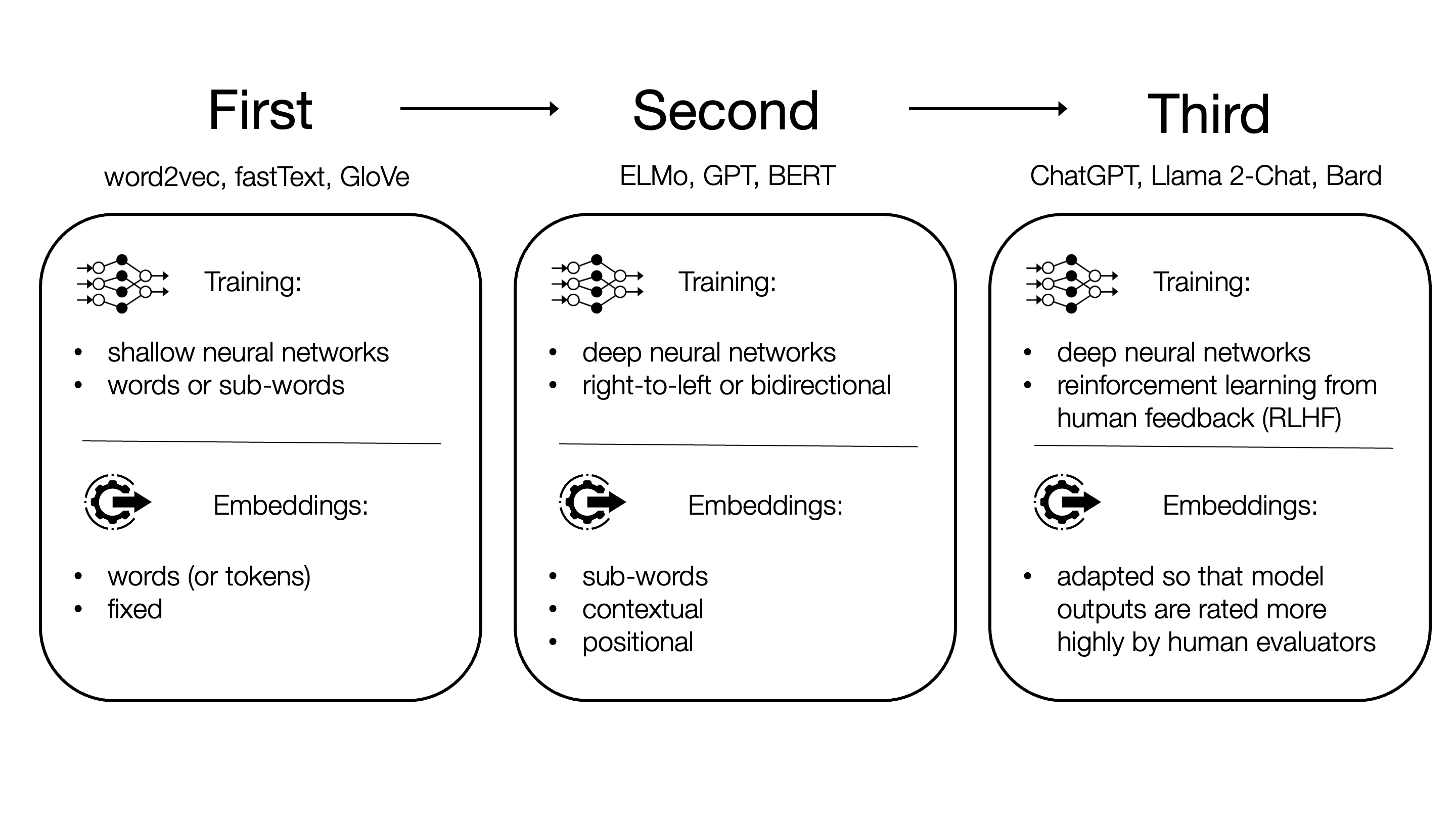
Emergence of ML
Advances in LLMs…
Allowing for out-of-vocabulary words (using sub-words or word-pieces for tokenizing).
Adding a sequence layer.
Sliding a context window both left-to-right and right-to-left.
Implementing self-attention architecture.
Training on more and more data.
Expanding the context window (from 512 word-pieces for BERT to 128,000 word-pieces for GPT-4 Turbo 128K).
Introducing reinforcement learning from human feedback (RLHF) with Instruct GPT.
Emergence of ML
An example of contextual embeddings using BERT
sentences = ["bank",
"He eventually sold the shares back to the bank at a premium.",
"The bank strongly resisted cutting interest rates.",
"The bank will supply and buy back foreign currency.",
"The bank is pressing us for repayment of the loan.",
"The bank left its lending rates unchanged.",
"The river flowed over the bank.",
"Tall, luxuriant plants grew along the river bank.",
"His soldiers were arrayed along the river bank.",
"Wild flowers adorned the river bank.",
"Two fox cubs romped playfully on the river bank.",
"The jewels were kept in a bank vault.",
"You can stow your jewelry away in the bank.",
"Most of the money was in storage in bank vaults.",
"The diamonds are shut away in a bank vault somewhere.",
"Thieves broke into the bank vault.",
"Can I bank on your support?",
"You can bank on him to hand you a reasonable bill for your services.",
"Don't bank on your friends to help you out of trouble.",
"You can bank on me when you need money.",
"I bank on your help."]Emergence of ML
An example of contextual embeddings using BERT
from collections import OrderedDict
context_embeddings = []
context_tokens = []
for sentence in sentences:
tokenized_text, tokens_tensor, segments_tensors = bert_text_preparation(sentence, tokenizer)
list_token_embeddings = get_bert_embeddings(tokens_tensor, segments_tensors, model)
# make ordered dictionary to keep track of the position of each word
tokens = OrderedDict()
# loop over tokens in sensitive sentence
for token in tokenized_text[1:-1]:
# keep track of position of word and whether it occurs multiple times
if token in tokens:
tokens[token] += 1
else:
tokens[token] = 1
# compute the position of the current token
token_indices = [i for i, t in enumerate(tokenized_text) if t == token]
current_index = token_indices[tokens[token]-1]
# get the corresponding embedding
token_vec = list_token_embeddings[current_index]
# save values
context_tokens.append(token)
context_embeddings.append(token_vec)Emergence of ML
Emergence of ML
Emergence of ML
Emergence of ML
Emergence of ML
LLMs have a broad range of applications…
- Generation tasks
- Chat bots
- Content creation
- Summarization
- Translation
- Classification tasks
- Text classification
- Segment classification
Emergence of ML
Just as they raise questions regarding…
- The production of content hallucinations (Ji et al. 2023; Zhang et al. 2023)
- Expressions of bias (Santurkar et al. 2023)
- A tendency to repeat back a user’s stated views (“sycophancy”) (Perez et al. 2022)
Investigating LLM-Generated Text
Investigating LLM-generated text
- A group in the Statistics & Data Science Department was inspired by claims that were circulating when ChatGPT was first introduced. (e.g., “Wow! I asked ChatGPT to write a podcast and it looks pretty good!!!”)
- We wondered what the text it produces looks like when it is repeated. (e.g., “What happens if you ask it to write 100 podcasts?”)
- We gave it the same writing prompt that students are given in 36-200, generated 100 introduction, and compared those with introductions written by the actual students and introductions that appear in published, data-driven, academic papers.
- Then, we tagged the data using Biber’s (1991) features (which counts things like passives, nominalizations, attributive adjectives, etc.).
Investigating LLM-generated text
- It turns out, machine-authored prose and human-authored prose don’t really look the same in their morphosyntactic and functional features. (DeLuca et al. 2025; Herbold et al. 2023; Markey et al. 2024)
Projection of student, published, and ChatGPT-generated writing onto the first two linear discriminants, based on the 67 Biber features.
Investigating LLM-generated text
Human-generated vs. machine-generated text
| ChatGPT n:100 |
Published n:100 |
Student n:100 |
R2 | p-value | |
|---|---|---|---|---|---|
| Features indicating human-generated writing | |||||
| adverbs | −0.97 | 0.23 | 0.74 | 0.52 | 0.00 |
| conjuncts | −0.75 | 0.62 | 0.13 | 0.32 | 0.00 |
| modal possibility | −0.71 | 0.04 | 0.66 | 0.32 | 0.00 |
| pronoun it | −0.56 | 0.04 | 0.53 | 0.20 | 0.00 |
| verb private | −0.56 | 0.04 | 0.51 | 0.19 | 0.00 |
| split auxiliary | −0.56 | 0.37 | 0.19 | 0.16 | 0.00 |
| that verb comp | −0.48 | 0.48 | 0.00 | 0.15 | 0.00 |
| prepositions | −0.46 | 0.34 | 0.12 | 0.11 | 0.00 |
| verb suasive | −0.45 | 0.12 | 0.34 | 0.11 | 0.00 |
| verb public | −0.47 | 0.23 | 0.24 | 0.11 | 0.00 |
Investigating LLM-generated text
Human-generated vs. machine-generated text
| ChatGPT n:100 |
Published n:100 |
Student n:100 |
R2 | p-value | |
|---|---|---|---|---|---|
| Features indicating machine-generated writing | |||||
| mean word length | 1.14 | −0.13 | −1.01 | 0.78 | 0.00 |
| modal predictive | 1.22 | −0.72 | −0.51 | 0.76 | 0.00 |
| gerunds | 1.11 | −0.56 | −0.55 | 0.62 | 0.00 |
| other adv sub | 0.94 | −0.70 | −0.24 | 0.47 | 0.00 |
| demonstratives | 0.88 | −0.70 | −0.19 | 0.43 | 0.00 |
| nominalizations | 0.71 | 0.00 | −0.71 | 0.34 | 0.00 |
| phrasal coordination | 0.65 | −0.20 | −0.45 | 0.22 | 0.00 |
Investigating LLM-generated text
- ChatGPT, for example, produces a more restricted set of modal verbs – one that is different from both expert and novice writers.
| Modal verb |
Absolute Frequency
|
Relative Frequency (per 105 words)
|
||||
|---|---|---|---|---|---|---|
| ChatGPT | Published | Student | ChatGPT | Published | Student | |
| Prediction | ||||||
| will | 199 | 96 | 39 | 206.75 | 15.25 | 28.52 |
| would | 0 | 28 | 10 | 0.00 | 4.45 | 7.31 |
| 'll | 0 | 0 | 1 | 0.00 | 0.00 | 0.73 |
| Possiblity | ||||||
| can | 5 | 199 | 68 | 5.19 | 31.61 | 49.72 |
| may | 0 | 91 | 46 | 0.00 | 14.45 | 33.64 |
| could | 0 | 43 | 15 | 0.00 | 6.83 | 10.97 |
| might | 0 | 19 | 6 | 0.00 | 3.02 | 4.39 |
| Necessity | ||||||
| should | 0 | 20 | 10 | 0.00 | 3.18 | 7.31 |
| must | 0 | 16 | 0 | 0.00 | 2.54 | 0.00 |
Investigating LLM-generated text
Human-generated vs. machine-generated text
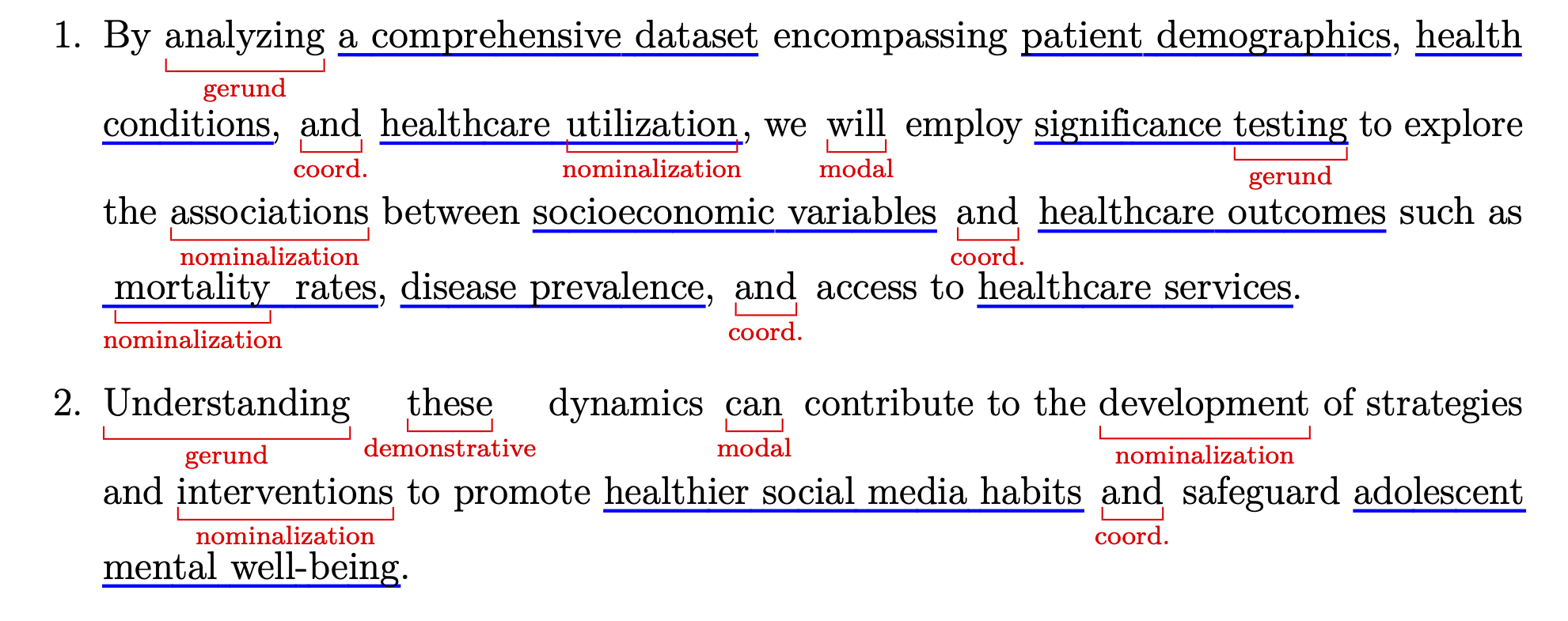
Investigating LLM-generated text
Lab Set Question
If you were working on this project, what would you suggest the team do next? In other words, what limitations do you see in the results of this initial study? What might be done to increase its reliability? Or its generalizability? And what potential challenges do you foresee in applying your suggestions? (Discuss with a couple of your neighbors and write your response)
Investigating LLM-generated text
- We also created an experiment at scale (Reinhart et al. 2025), with 10,000 samples, across 9 text-types.
| Statistic | Score | CI |
|---|---|---|
| SENS | 0.940 | 0.93-0.94 |
| SPEC | 0.952 | 0.95-0.96 |
| MCC | 0.892 | NA |
| Informedness | 0.892 | NA |
| PREC | 0.952 | 0.95-0.96 |
| NPV | 0.940 | 0.93-0.95 |
| FPR | 0.048 | NA |
| F1 | 0.946 | NA |
| TP | 7553.000 | NA |
| FP | 383.000 | NA |
| TN | 7581.000 | NA |
| FN | 483.000 | NA |
| AUC-ROC | 0.980 | 0.98-0.98 |
| AUC-PR | 0.880 | NA |
| AUC-PRG | 0.910 | NA |
Investigating LLM-generated text
- We also created an experiment at scale (Reinhart et al. 2025), with 10,000 samples, across 9 text-types.
ROC curve for human vs. ChatGPT 3.5.
Investigating LLM-generated text
- We also created an experiment at scale (Reinhart et al. 2025), with 10,000 samples, across 9 text-types.
ROC curve for human vs. ChatGPT 4.
Investigating LLM-generated text
- We also created an experiment at scale (Reinhart et al. 2025), with 10,000 samples, across 9 text-types.
Question
Does this set off alarm bells? Does it look too good to you? How would you check that something hasn’t gone wrong?
Investigating LLM-generated text
- One way would be to test the consecutive chunks of human-generated text.
ROC curve for human chunk 1 vs. human chunk 2.
Investigating LLM-generated text
- What if we tried multiclass (rather than binary) classification of 4 different models (ChatGPT 3.5, ChatGPT 4.0, Llama 3 8B-Base, and Llama 3 8B-Instruct) and human generated text?
| Generator | Human | GPT-3.5 | GPT-4 | 8B-Base | 8B-Instruct |
|---|---|---|---|---|---|
| Human | 94.0% | 1.7% | 1.0% | 1.9% | 1.3% |
| GPT-3.5 | 5.9% | 72.7% | 3.0% | 5.4% | 13.0% |
| GPT-4 | 1.3% | 2.6% | 93.1% | 1.8% | 1.2% |
| 8B-Base | 5.7% | 2.3% | 2.3% | 85.3% | 4.5% |
| 8B-Instruct | 3.5% | 11.5% | 1.8% | 6.3% | 76.9% |
Investigating LLM-generated text
- Many of the features are the same ones we saw in the smaller study.
| Features in human- and LLM-written text | |||||||
|---|---|---|---|---|---|---|---|
| Rate per 1,000 tokens; LLM rates relative to Chunk 2 | |||||||
| Feature |
Human
|
GPT
|
Llama 3
|
Importance | |||
| Chunk 1 | Chunk 2 | GPT-3.5 | GPT-4 | 8B-Base | 8B-Instruct | ||
| present participle | 1.9 | 1.8 | 343% | 404% | 83% | 200% | 1,930.5 |
| adverbs | 61.8 | 64.9 | 70% | 95% | 105% | 76% | 1,271.3 |
| prepositions | 102.8 | 100.1 | 121% | 115% | 86% | 98% | 1,014.7 |
| phrasal coordination | 6.7 | 6.5 | 216% | 191% | 82% | 195% | 1,010.7 |
| downtoners | 2.0 | 2.1 | 71% | 154% | 70% | 53% | 947.8 |
| that subj | 2.7 | 2.5 | 218% | 217% | 78% | 186% | 929.3 |
| infinitives | 15.8 | 16.9 | 105% | 78% | 122% | 142% | 814.5 |
| adj attr | 48.3 | 45.8 | 126% | 160% | 79% | 100% | 800.3 |
| nominalizations | 16.1 | 16.1 | 192% | 207% | 90% | 147% | 770.1 |
| mean word length | 4.6 | 4.6 | 107% | 114% | 99% | 101% | 716.0 |
Implications
Key takeaways
- Although ChatGPT seemed to explode into the public consciousness, it is part of a surprisingly long history of technological development.
- The engineering behind LLMs is incredibly complex; however, the linguistic principles that they’re based on are relatively simple.
- Understanding both these principles and this history can help you if you’re tasked with building, evaluating, or using these systems.
- Even a relatively simple-seeming research inspiration (“Hey, let’s compare human writing to ChatGPT!!!”) can lead to a complex set of choices and an iterative process of research design and evaluation.
- We’ll talk more about this in our first lab next week and the need for considered research questions and project planning.